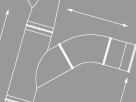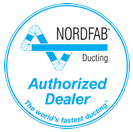
Understanding the Engineering Specs of Nordfab® QF® Ducting
Nordfab® manufactures clamp-together, Quick-Fit®, modular ducting that works by utilizing a single lever to clamp enclosed rolled edges at the ends of each pipe. Nordfab® QF ducting and clamps are constructed of similar materials.
During the manufacturing process, 5-foot duct material sheet blanks are rolled and fused together along the longitudinal seam through a laser weld process that prevents gaps from forming in the rolled edge.
Each pipe is checked with a light apparatus to ensure there are no welding flaws or gaps.
The rolled edge is then die-formed after inspection by rolling each end of the pipe simultaneously.
Rolled ends are used for clamping components together as well as offering reinforcement every 5-feet.
All Quick-Fit® clamps contain a standard gasket made of Nitrile which is suitable for most applications. For higher temperature applications, silicone and ePTFE gasket options are available. Nordfab® Ducting is available in 1-inch increments sized 3" to 24" diameters.
Engineering Specification:
-
A. Ducting shall consist of the following:
-
A. Galvanized: ASTM A653 with a G90 rating
-
A. Recommended max. service temperature is 390° F. At higher temperatures ranging between 390° F and 480° F, the zinc-iron alloy layers in galvanized steel will continue to provide a high level of protection from corrosion. However, there may be some peeling, changes in mechanical properties, and reduction in the corrosion protection. (Recommended temperature is based upon information from the American Galvanizers Association)
-
A. Temp rating is 1,100° F
-
A. Temp rating is 1,100° F
B. Ducting Manufacturing Techniques:
- A. Diameters 3″ – 24″ Quick-Fit® Pipe, QF Adjustable Nipples, and collars attached to other components will have one or both ends die formed-rolled to provide a uniform edge around the circumference of the rolled end. The pipe and adjustable nipples shall have the longitudinal seam laser welded to allow for a tighter slip joint and reduce system pressure losses. All laser welded seams will undergo a light test to ensure there are no voids or imperfections in the system. Pipe lengths using laser welded seams will not exceed a nominal 60″ length. The rolled edges provide structural support at 5′ intervals or less and can be interpreted as a stiffener where SMACNA specifications are required. An adjustable nipple is used for adjustment during the install process. Pipe is cut to appropriate length and the adjustable nipple secures the pipe for install.
B. Pipe and other components larger than 24″ shall utilize either an angle flange or flat flange attached loosely and retained in place using a 3/8″ vanstone lip. The pipe shall have a solid welded seam and not exceed 78″ in length. The angle or flat flanges provide structural support at 6’-6” intervals or less and are considered as stiffeners where SMACNA specifications are required.
C. There will be times when certain components will be air direction sensitive. These components will have an arrow sticker attached showing the proper flow direction.
D. All QF ducting and its components shall have been tested to 80″ WG using the following gauged reference:
-
A. 3″ through 12″ will use 22ga material thickness
B. 13″ through 29″ will use 20ga material thickness
C. 30″ and above will use 18ga material thickness
C. Clamping Rolled Edged Duct:
-
A. Clamps shall be constructed with an over-center, spring-lever action for quick connecting of two pieces of ducting. A retaining pin shall be inserted in the handle and an eyelet on the clamp as a safety feature to ensure the handle does not prematurely come undone.
B. When closing the clamp, the internal seal shall be compressed in such a manner as to cover both rolled beads for optimum sealing capacity in a full 360° pattern.
D. Optional Caulking and Other Materials Governing System Temperature Ratings if Applicable:
-
A. Approved caulk is 3M Scotch Seal Metal Sealant 2084 or equivalent for system temperatures of 250°F or lower
B. Optional approved caulk is 3M Polyurethane Adhesive Sealant 540 or equivalent for system temperatures of 250°F or lower
C. Optional approved caulk is Rock River Silicone Sealant or equivalent for system temperatures of 400°F or lower
D. Optional approved caulk is Red Devil HVAC/R High TemperatureSilicone Sealant (red in color) or equivalent for system temperatures of 500°F or lower
E. Sealing o-rings
-
A. Buna-N, 70 Duro-Meter hardness with a temperature rating of 250°F maximum and is black in color, used with the adjustable nipple
B. Silicone rubber, ZZ-R-765 Class 2A and 2B grade 770 AMS-3304E and 3304F and 3303G, FDA approved and is red in color, used with the adjustable nipple
G. Sponge o-ring shall meet the material classification of either ASTM D-1056-68 – SBE43 or ASTM D1056-85, 91, 98 – 2B3
E. Clamp seals shall be made of either of the following:
-
A. Nitrile to meet or exceed ASTM D 1056 standards with a temperature rating not to exceed 158°F constant temperature (or intermittent temperature of 194°F).
B. Silicone to meet or exceed ASTM-D-2000 M1GE605 – ZZ-R-765 Class 2 Grade 50 – AMS-3302. Temperature rating shall not exceed 400°F.
C. ePTFE not degraded by any common chemicals in the 0-14 PH range. Temperature rating shall not exceed 600°F.
Conductivity:
Metal-to-metal contact shall be obtained at all joint connections. Die-formed rolled edges are uniform in shape which provides the most consistent contact. The ears of the clamp contact with the rolled edges and provide maximum conductivity. Testing is the responsibility of the owner.






